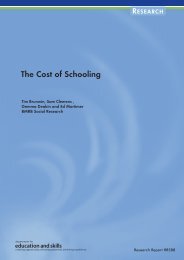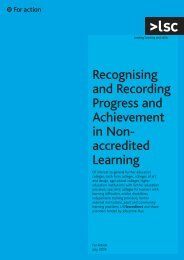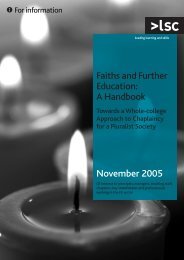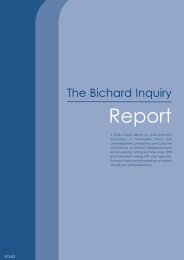Full Text (PDF) - Official Documents
Full Text (PDF) - Official Documents
Full Text (PDF) - Official Documents
Create successful ePaper yourself
Turn your PDF publications into a flip-book with our unique Google optimized e-Paper software.
Managing the expansion of the Academies Programme Summary 9<br />
The cost of the expanding Programme<br />
15 In the two years from April 2010 to March 2012, the Department spent<br />
£8.3 billion – 10 per cent of its total revenue spend on schools – on the<br />
Programme. An estimated £1.0 billion of this was additional cost to the<br />
Department (see footnote 1). It spent £49 million on central Programme administration,<br />
£338 million on transition costs, £92 million on academy insurance, £22 million on<br />
support for academies in deficit, £68 million reimbursing academies’ VAT costs,<br />
and £29 million on other grants. The Department also chose to spend £21 million<br />
double‐funding academies and local authorities to ensure sustainability of some local<br />
authority services, and £59 million protecting academies against year-on-year volatility in<br />
their income. A further £350 million was money the Department was not able to recover<br />
from local authorities to offset against academy funding, and which therefore remained<br />
in the local authority system. In 2011-12, the Department sought to increase the amount<br />
it recovered by transferring local authority funding from the Department for Communities<br />
and Local Government. However, it underestimated the number of new academies<br />
for which to do so. It also agreed to repay local authorities £58 million (included in<br />
the £350 million above) after some authorities challenged the fairness of the transfer<br />
calculation (paragraphs 2.2–2.6, 2.11).<br />
16 The estimated annual additional cost of the Programme has increased as<br />
numbers of academies have grown, and the Department’s estimates suggest it<br />
will continue to do so in 2012-13. However, the Department reduced its additional<br />
recurrent cost per open academy by 53 per cent between 2010-11 and 2011-12,<br />
mainly because it recovered a greater proportion of funding from local authorities,<br />
and because academies’ VAT costs are now refunded by HMRC rather than the<br />
Department. The Department has also reduced transition funding for sponsored<br />
academies, and plans to reduce this further during 2012/13. It expects that planned<br />
changes to the funding system in 2013/14, and ongoing improvements in forecasting<br />
academy numbers, will support further cost reductions and improved cost forecasting<br />
(paragraphs 2.14–2.16).<br />
Financial management, governance and oversight<br />
17 The Department relies on the quality of academies’ financial management<br />
and governance to ensure effective and proper use of public money. The EFA<br />
considers less than 1 per cent of academies to be at significant financial risk, and our<br />
survey suggests a higher proportion of academies are complying with basic good<br />
governance than in 2010. To date, there have been few investigations into financial<br />
mismanagement and governance failure. However, in addition to their impact at academy<br />
level, such failures create the risk of wider reputational damage to the Programme.<br />
In September 2012, the EFA issued new guidance, emphasising its expectations of<br />
academy trust accounting officers and governing bodies (paragraphs 3.4–3.9).

















